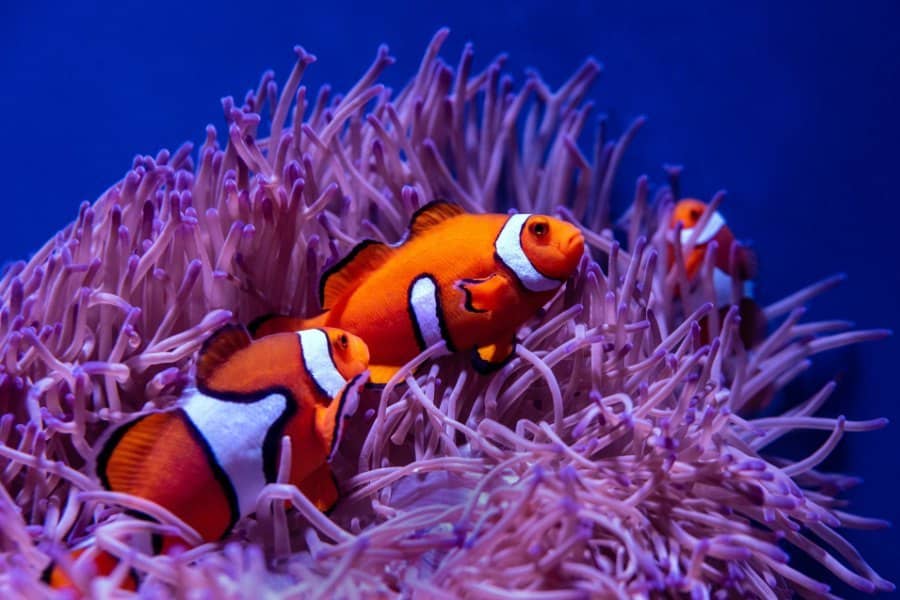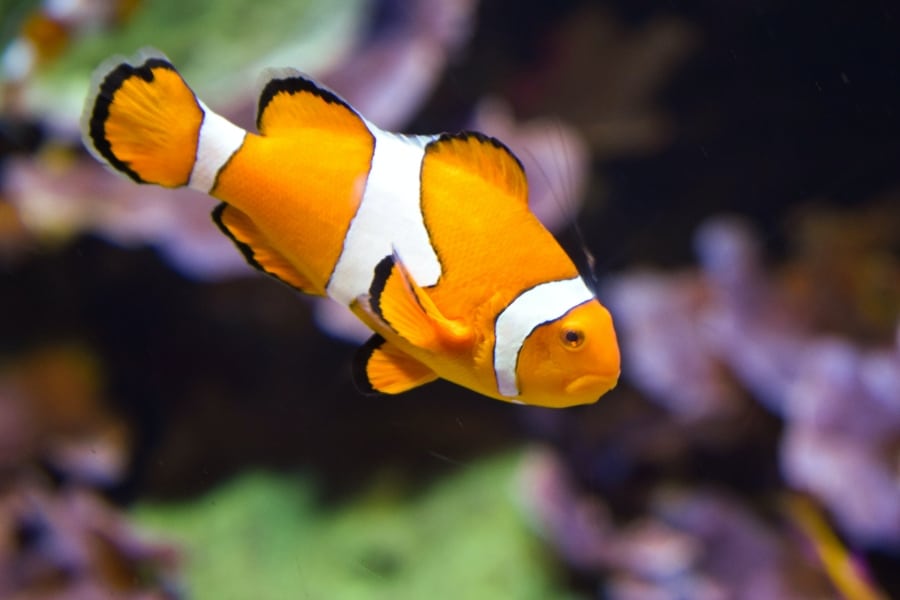Clownfish are famous and beautiful fish species. They are also the first choice of new fish keepers or enthusiasts due to their eye-catching colors. But many fish hobbyists or fish keepers are unaware that there are several different clownfish types.
This article will walk you through the basics of clownfish as well as some of the most well-known species of clownfish in the aquarium hobby.
But first, let’s discuss the following chart that depicts the number of clownfish species along with their average size and lifespan.
| Number of Clownfish Species | 30 |
| Average Length | 2.7 – 6.8 inches |
| Average Lifespan | 7 – 12 years |
15 Most Well-Known Clownfish
These are some of the most well-known species of clownfish found in saltwater, even though there are thousands of different color variations among the many different types of clownfish species.
1. Ocellaris Clownfish (Common or False Clownfish)
- Scientific name: Amphiprion ocellaris
- Care Level: Moderate
- Diet: Omnivore
- Maximum body size: 3 inches
- Temperament: Peaceful
- Recommended tank size: 20 gallon
In contrast to other species of clownfish, the ocellaris clownfish are wonderful tankmates because they are so peaceful. They are omnivorous and can live in reef environments. They only grow to be 3 inches long when mature, so they need a tank that is only 20 gallons in capacity.
The popularity of these fish skyrocketed after Disney introduced them. They have bodies that are primarily comprised of vibrant orange color, and each fin has a black outline. They have three stripes that run vertically over their face, body, and tail sections.
Even a beginner will have no difficulty getting a hold of taking care of these fish because the tasks involved are so simple.
2. Maroon Clownfish
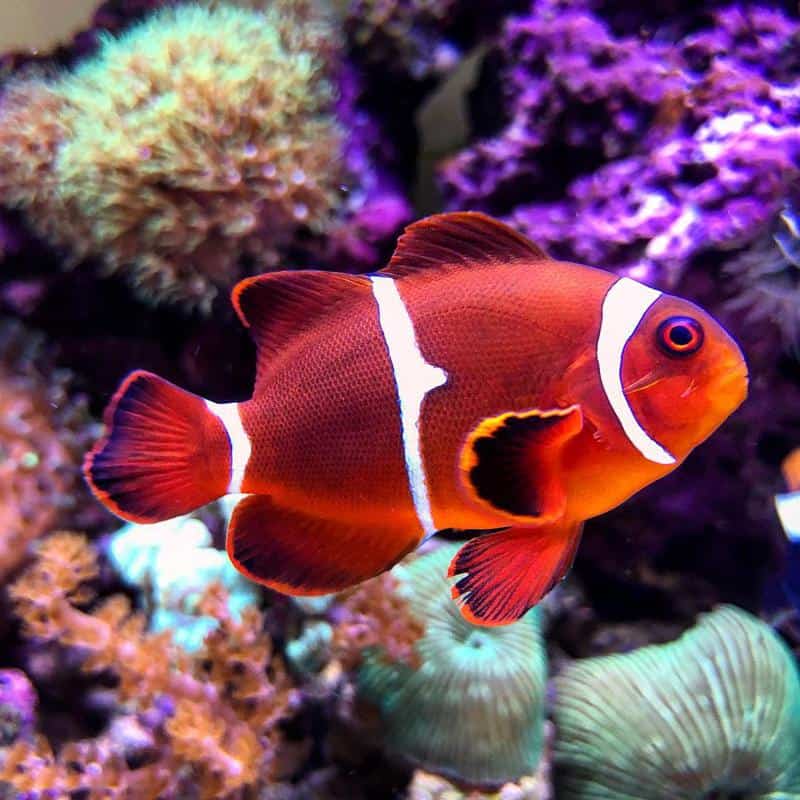
- Scientific name: Premnas biaculeatus
- Care Level: Moderate
- Diet: Omnivore
- Maximum body size: 6-6.3 inches
- Temperament: Semi-aggressive and territorial
- Recommended tank size: 40 gallon
The Maroon Clownfish is a well-liked member of the vast family of clownfish. These fish are easily distinguished by their maroon coloring and distinctive three-strip pattern (Gold or white). They may also be enormous, reaching lengths of 6 to 6.3 inches.
Much like the bulk of its fellow Clownfish relatives, the Maroon Clownfish are exceptionally resilient, making them an excellent choice for individuals who are just starting in the hobby or do not have enough time on their hands.
The only thing you need to be wary of is the fact that they have a tendency toward hostility. They are capable of developing a strong sense of territoriality and may even bully members of other clownfish species.
3. Snowflake Clownfish
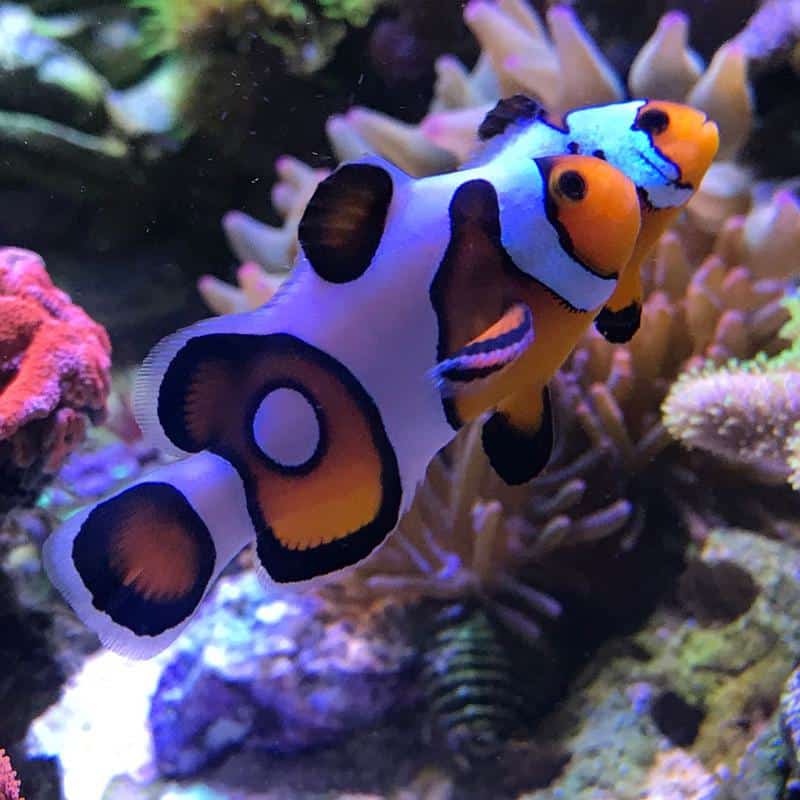
- Scientific name: Amphiprion ocellaris
- Care Level: Beginner
- Diet: Omnivore
- Maximum body size:5 inches
- Temperament: Little bit aggressive
- Recommended tank size: 15 gallon
One of the varieties of clownfish that are grown specifically for the purpose of being marketed as pets is referred to as the snowflake clownfish. Due to the fact that they inhabit salt water, like the majority of species, they are readily available at pet stores.
Snowflake Clownfish are easily distinguished from other clownfish due to the white pattern found on their skin. They are a kind of bred clownfish that are readily available at pet stores because they are one of the most sought-after sorts.
It is possible to refer to clownfish of this sort as “dotted eye” based on the color pattern it possesses. However, snowflake clowns are easily distinguished from other forms of clownfish due to the white texture that they possess.
4. Tomato Clownfish
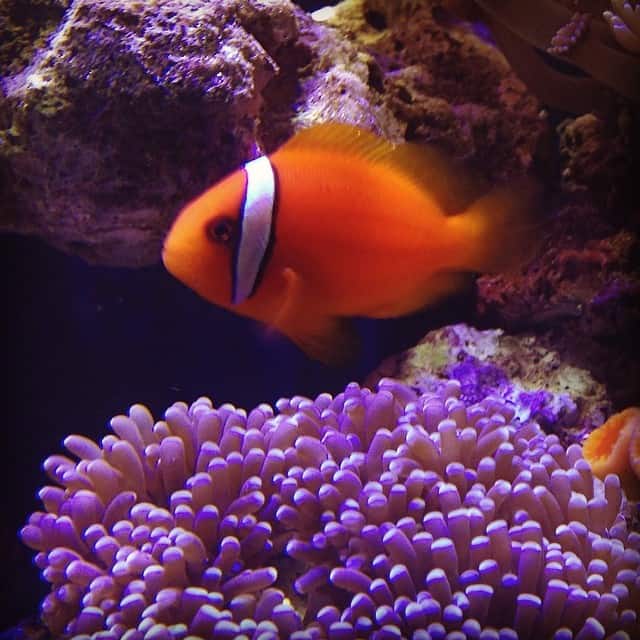
- Scientific name: Amphiprion frenatus
- Care Level: High
- Diet: Omnivore
- Maximum body size:2 inches
- Temperament: Aggressive
- Recommended tank size: 20-40 gallon
The tomato clownfish is another species of clownfish that may grow to be quite large. Their coloring is consistent, and they do, in fact, have the appearance of a tomato, which is where they get their name from. As a result, it ranges from brilliant orange to an almost crimson color.
In particular, this kind of fish has only a single, prominent vertical stripe that extends all the way to the back of its head after its eyes. It shouldn’t come as a surprise to clownfish enthusiasts to find that this species is one of the most popular options for pets among many contemporary aquarists because it is such a lovely species.
The body length of the tomato clownfish can reach a maximum of 5.2 inches, so you should prepare to provide it with a sufficient quantity of appropriately shaped flakes or pellets as food. When it comes to the size of the aquarium, it is recommended that an individual have at least 20 gallons tank, but a happy pair may be kept in a tank that is 40 gallons.
Although this species matures into a more aggressive form, it gets along well enough with other semi-aggressive fish like angelfish that it’s not a bummer.
You should give your tomato clownfish some anemones in order to reduce the amount of stress they are under. Last but not least, these adorable fish may live in captivity for around 15-16 years if they are given excellent living circumstances.
5. Picasso Clownfish
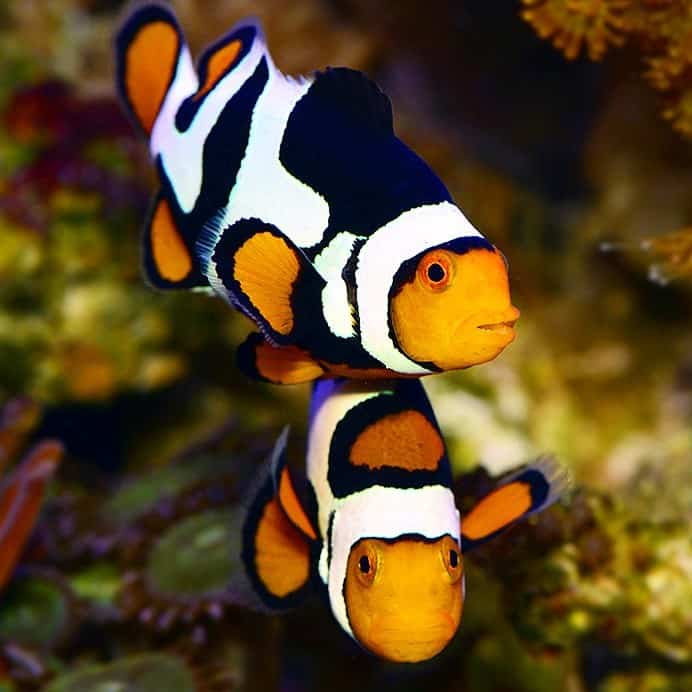
- Scientific name: Amphiprion percula
- Care Level: High
- Diet: Omnivore
- Maximum body size: 3 inches
- Temperament: Somewhat peaceful
- Recommended tank size: 25 gallon
These little clownfish really are an example of a piece of art created by nature. Their foundational color is still a brilliant orange, as it is in the vast majority of other species of clownfish, but the black and white streaks that run across their bodies set them apart.
However, some variants can have bodies of a white tint with orange spots and black lines, while others can have the opposite combination of colors. And there is just no way for us to choose which of the two is the more breathtaking!
Picasso clownfish are a kind of clownfish that are typically under 3 inches in length. On the other hand, the price of these fish more than makes up for their little stature. In point of fact, this particular kind of clownfish is among the most costly options accessible. The more exclusive something is the higher its price.
You can anticipate these creative fish to survive for at least 12 years if you take care of them properly and keep them in a tank with at least 25 gallons of capacity.
6. True Percula Clownfish
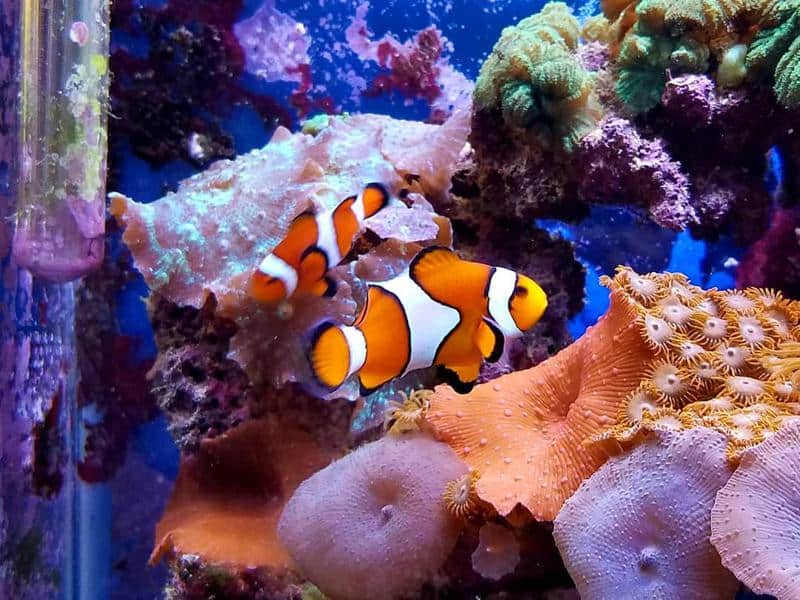
- Scientific name: Amphiprion percula
- Care Level: High
- Diet: Omnivore
- Maximum body size:3 inches
- Temperament: Semi-aggressive
- Recommended tank size: 10 gallon
This particular variety of clownfish is not only the tiniest but also one of the cutest that can be found. Because the body length of a percula clownfish can only reach a maximum of two or three inches, these fish are particularly susceptible to being injured or killed by other fish in the tank, as well as by harsh water conditions.
Even though they are recognized as the most docile and least territorially hostile species, they are still susceptible to being bullied, so you should make sure to supply your pet Percula with many hiding places as well aquarium mates that have been appropriately chosen.
One specimen of this fish can live happily in a 10-gallon tank. On the other hand, if you want to introduce more fish to them, you will need an aquarium of at least 20 gallons.
Regardless of what you decide to keep in your aquarium, this fish species will definitely provide a splash of crimson, white, and black colors. Do not be deceived by their small size, as these fish may live for up to twenty years in aquariums if adequately cared for.
7. Mocha Clownfish
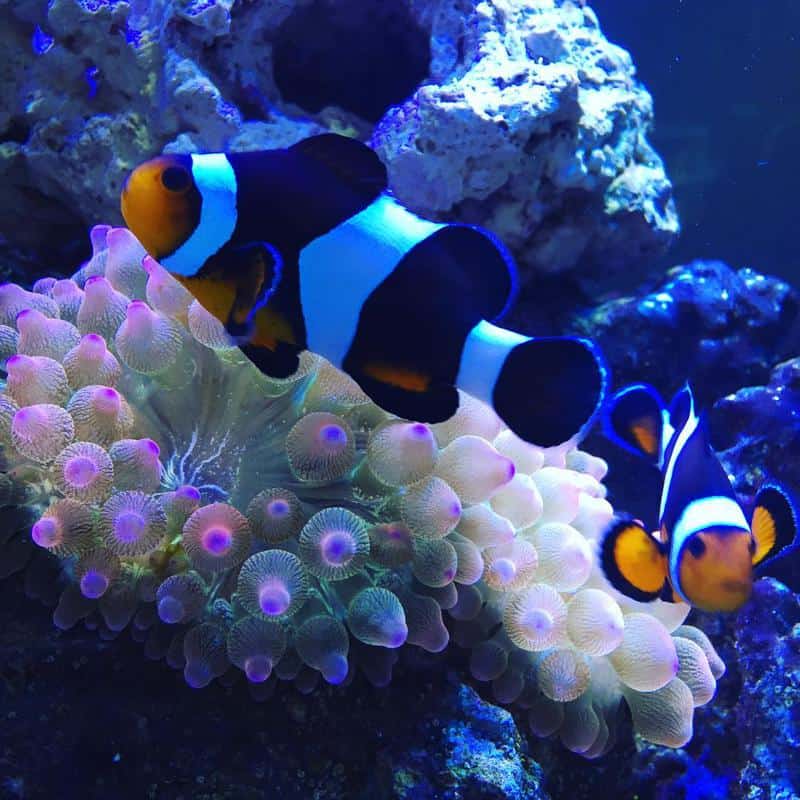
- Scientific name: Amphiprion ocellaris
- Care Level: Beginner
- Diet: Omnivore
- Maximum body size: 3 inches
- Temperament: Somewhat peaceful
- Recommended tank size: 30 gallon
As is the case with the vast majority of clownfish varieties, the mocha clownfish are bred specifically for the purpose of being kept as a pet. Due to the fact that it inhabits saltwater, it is frequently seen at pet stores.
When compared to other varieties of clownfish, Mocha Clowns are pretty noticeable due to the white pattern on their skin.
8. Wyoming White Clownfish
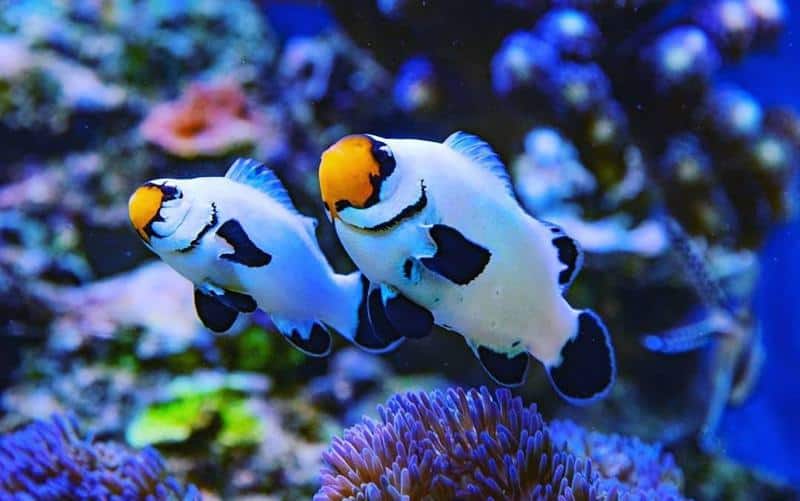
- Scientific name: Amphiprion ocellaris
- Care Level: Moderate
- Diet: Omnivore
- Maximum body size: 4 inches
- Temperament: Semi-Aggressive
- Recommended tank size: 25-30 gallon
The Wyoming white clownfish can naturally be found in Fiji’s seas. It is estimated that less than 500 specimens of this variety have ever been collected, making it one of the rarest clownfish types in the world.
Although they eventually reach an average length of approximately an inch, most of them are only about half that tiny when they are first born. The Wyoming white clownfish feed primarily on plankton and algae that are suspended in the water column.
To obtain these foods, the Wyoming white clownfish ventures out into the open water for an instant at a time to consume them before swimming back to its host. They often come out at night, and the early morning is the time of day when they are the most active. You can also keep their pets, but they are tough to care for.
9. Clarkii Clownfish
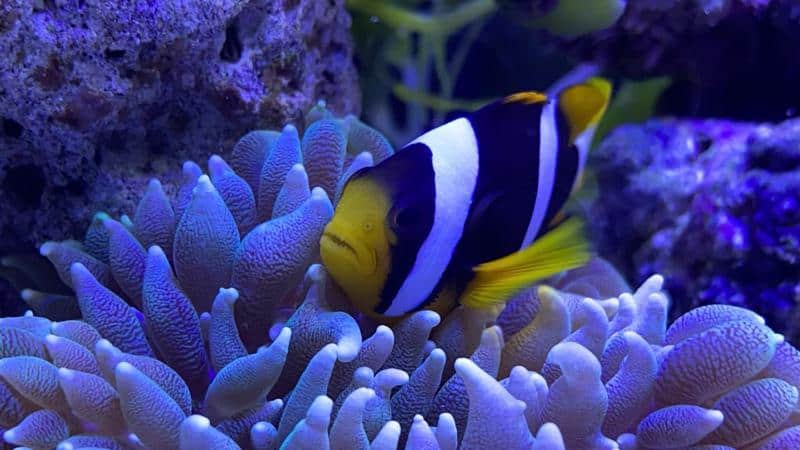
- Scientific name: Amphiprion clarkii
- Care Level: Moderate to High
- Diet: Omnivore
- Maximum body size: 5 inches
- Temperament: Little bit aggressive
- Recommended tank size: 30-40 gallon
The Clarkii Clownfish is a saltwater fish that is known for its exceptional durability and makes an excellent addition to any type of home tank, including reef aquariums.
They are simple to recognize since their bodies are marked with two broad, white bands. They can occasionally be identified by a third band that is located close to the base of the tail. It is possible to recognize a Clarkii Clownfish by its brilliant nose and tail fin, which can range in color from white to yellow.
These clownfish like swimming in open water and will frequently leave the protection of their anemone habitat in order to find food. Because they are more daring and exploratory than other clownfish species, you can give your aquarium an additional degree of appeal.
The Clarkii Clownfish may reach lengths of up to six inches. On the other hand, their max body length in a home aquarium is often 5 inches.
10. Cinnamon Clownfish
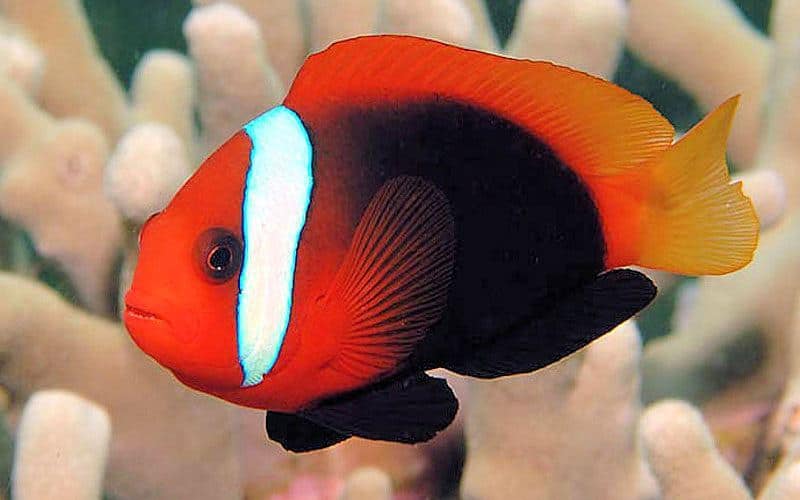
- Scientific name: Amphiprion melanopus
- Care Level: Moderate to High
- Diet: Omnivore
- Maximum body size: 4 inches
- Temperament: Territorial
- Recommended tank size: 30 gallon
There are a few different names for cinnamon clownfish, the most common of which are fire clownfish and red Anemonefish. These fish have a coloration between orange and dark red and a thick white stripe that runs vertically behind each eye.
The cinnamon clownfish consume various foods and can be aggressive toward other fish species. If you want one of these guys to have room to roam, you’ll need a tank that’s at least 30 gallons in size because they grow to be an average of 4 inches long as adults. These fish have been known to live as long as 15-18 years.
Because of their exceptional resilience, the particular clownfish are beautiful additions to the aquariums of both novices and seasoned aquarists.
11. Pink Skunk Clownfish
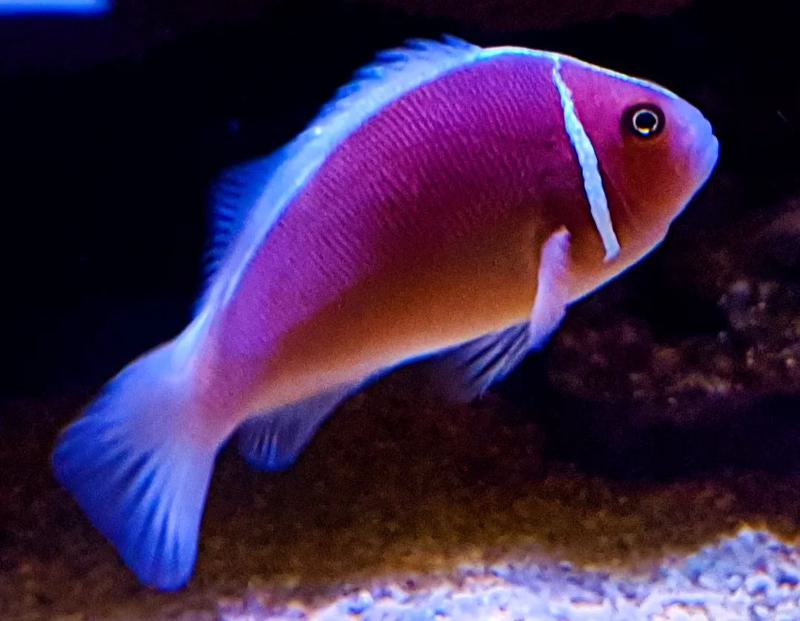
- Scientific name: Amphiprion perideraion
- Care Level: High
- Diet: Omnivore
- Maximum body size: 4 inches
- Temperament: Semi-aggressive
- Recommended tank size: 15-25 gallon
This Clownfish has a body color between tangerine and peach and a single white stripe on its head. The mark may begin at the nose’s tip and continue down the back. In addition to that, there is an additional white stripe that contrasts with the black directly behind the eyes.
The majority of the fish that you may get at your neighborhood pet store were bred in aquariums. This indicates that they are suitable for use in home aquariums as well as being easy to transport. They won’t trouble you when you try to introduce them to your home tank. You’ll discover they are an excellent addition to a tank that houses coral reefs.
Because of their low price and high-stress resistance, these clownfish are an excellent choice for both beginner and experienced aquarium keepers.
12. Mccullochi Clownfish (McCulloch’s Anemonefish)
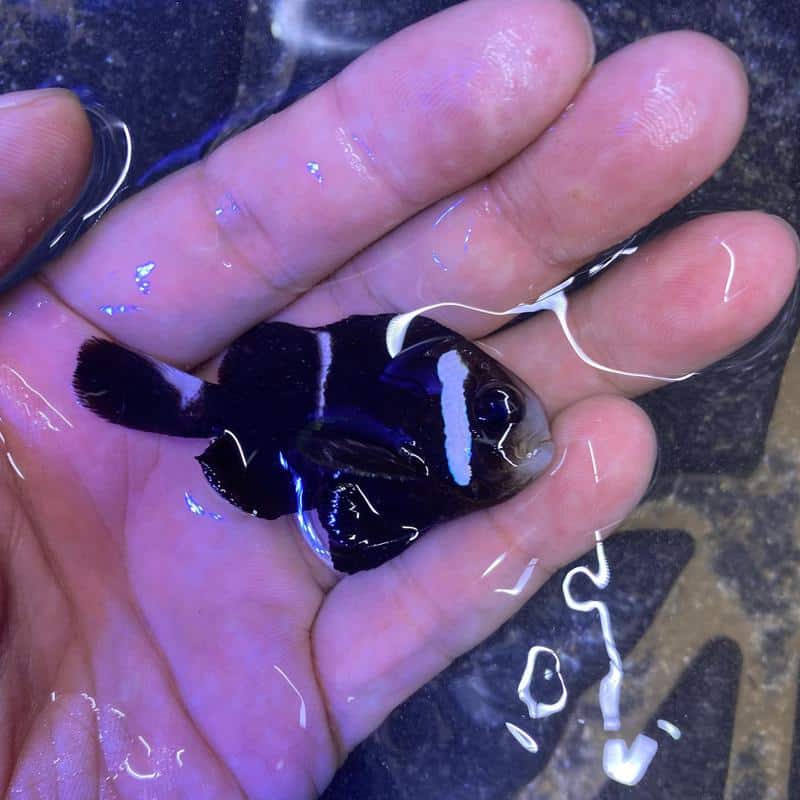
- Scientific name: Amphiprion mccullochi
- Care Level: Moderate
- Diet: Omnivore
- Maximum body size: 7 inches
- Temperament: Semi-aggressive
- Recommended tank size: 30 gallon
The McCullock’s Anemonefish, which is sometimes referred to as the Whitesnout clownfish, is one of the rarest species of clownfish that may be found in aquariums.
It features white bands on either side of its head, a vivid tail, and a white or light bluish-white shout. Its body can range in color from dark brown to dark blue or even black.
When compared to other species of clownfish, McCulloch’s Anemonefish is significantly larger.
Its maximum length is 4.7 inches, and it is recommended to be housed in a tank of at least 30 gallons in capacity.
McCulloch’s Anemonefish are pretty pricey, but that makes sense, given how rare and difficult it is to get this species.
In any case, if the price tag isn’t enough to deter you from purchasing a Whitesnout Clownfish, but you still don’t want to take any chances, be sure the fish was raised in captivity. It is because clownfish that have been reared in captivity are acclimated to the environment of a home aquarium and are much simpler to care for.
13. Orange Skunk Clownfish
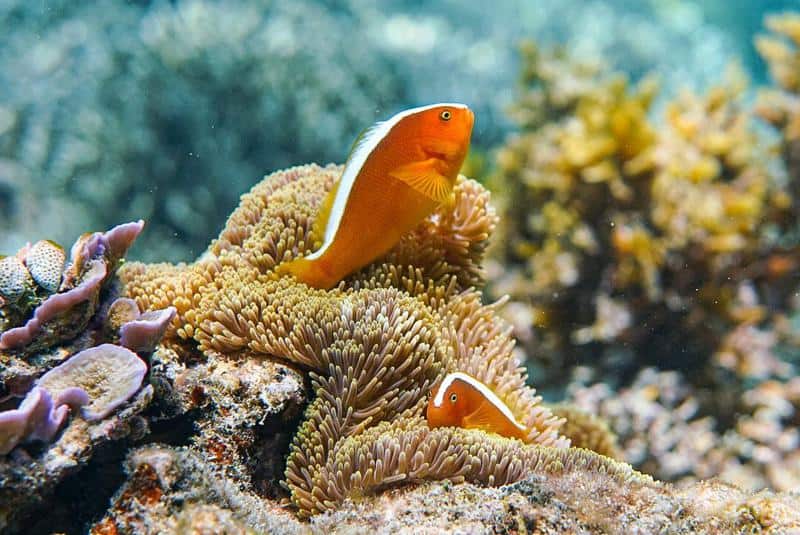
- Scientific name: Amphiprion sandaracinos
- Care Level: Moderate
- Diet: Omnivore
- Maximum body size:5-4 inches
- Temperament: Little bit aggressive
- Recommended tank size: 30 gallon
The Orange Skunk Clownfish has a light orange color overall and has a single white stripe behind its head. This single white stripe covers the whole length of the back.
There are many different colors of Skunk Clownfish, but the orange type is particularly well-liked among novice fish keepers.
These clownfish may grow to a maximum size of 3.5 to 4 inches, making them an excellent choice for a tiny saltwater aquarium. A common misconception is that clownfish and anemones must always be kept together. Having said that, this is not always the case with orange skunk clownfish.
14. Sebae Clownfish
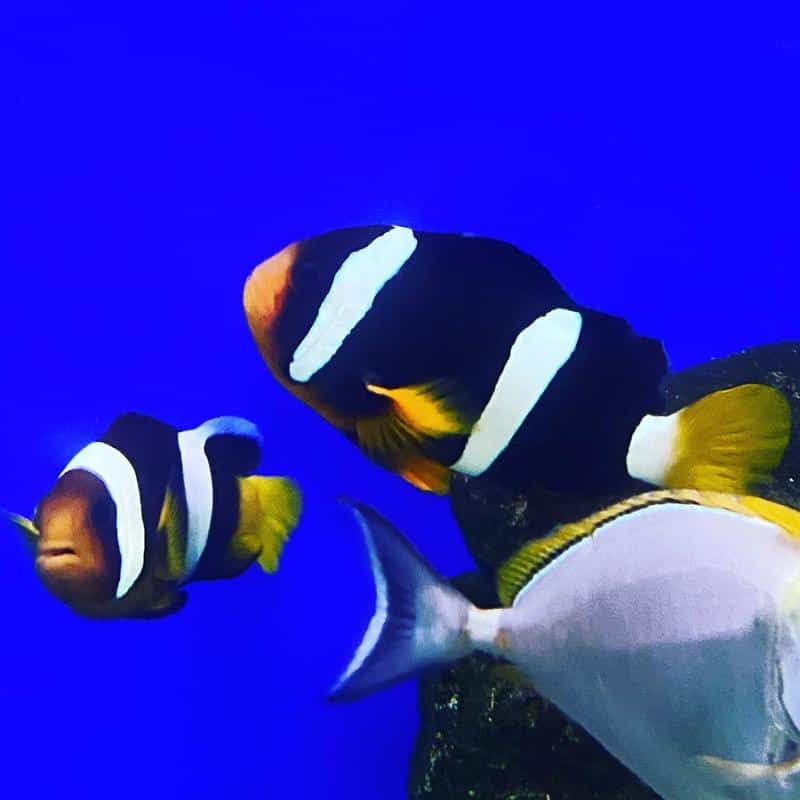
- Scientific name: Amphiprion sebae
- Care Level: Moderate
- Diet: Omnivore
- Maximum body size: 5 inches
- Temperament: Semi-aggressive
- Recommended tank size: 30 gallon
Sebae Clownfish are a clownfish variety that lives in groups and creates intricate social hierarchies. Their heads and fins are striped with white, and their bodies are orange with white stripes. There are wide different varieties of clownfish, and you may find them all the way from the Indian Ocean to Japan, including in Southeast Asia and Indonesia.
They inhabit the shallow waters along coastal reefs as well as waters with depths ranging from 0 to 30 meters. They are difficult to find in pet stores and somewhat more costly than other clown fish. However, their beauty justifies their price.
15. Oman Clownfish
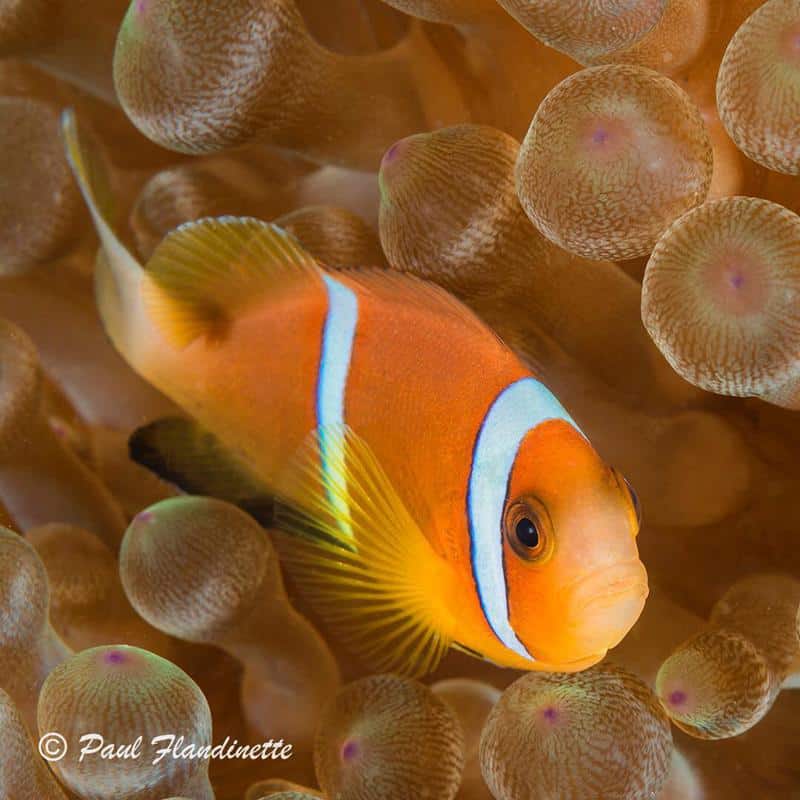
- Scientific name: Amphiprion omanensis
- Care Level: Beginner
- Diet: Omnivore
- Maximum body size: 1 inches
- Temperament: Semi-aggressive
- Recommended tank size: 30-40 gallon
The Oman clownfish is a specimen with a mild coloration and has a pale orangey-brown body and fins that are a light orange color. These fish have two prominent white stripes that go down their midsection and around the front of their heads.
With an average length of 6.1 inches, the Oman clownfish is one of the biggest species of clownfish. These fish are omnivores and can be slightly hostile to the other fish in their aquarium. Always keep a close watch on how they interact with the other fish in the tank. They must have a tank with at least 30 gallons of capacity to swim.
Because of their high level of versatility, these species are an excellent option for inexperienced enthusiasts.
Also Read:
- Can a Clownfish Live in Freshwater?
- Best Clownfish Tank Mates
- What Do Clownfish Eat?
- Real-Life Fish Featured in Finding Nemo
Smallest Clownfish – True Percula Clownfish
The Orange clownfish also referred to as the True Percula Clownfish, is the tiniest clownfish (ranging between 2.5 to 3 inches) and is one of the most sought-after types of clownfish.
Percula is only found in a small portion of the earth, mainly in the regions close to New Guinea and eastern Australia. The pectoral fins on their bodies move in a graceful pedaling motion and have a waddling appearance while swimming.
Biggest Clownfish – Gold Stripe Maroon Clownfish
The length of the Gold stripe maroon clownfish, which may grow up to 6.3 inches, makes it the biggest species of clownfish. The body is maroon, and there are three big yellow body stripes across its surface.
There is also a species of Maroon Clownfish known as the White Striped Maroon Clownfish. This type is quite similar to the Gold Striped Maroon Clownfish; however, it has three excellent white lines instead of stripes and is not bigger than the Gold striped maroon clownfish.
The Maroon Clownfish belongs to the genus Premnas, distinguishing it from other clownfish species belonging to the genus Amphiprion. Premnas is a Latin word that translates to “spiny cheek,” If you look closely, you can see spines growing from either side of the body behind the eyes.
The Clownfish: Some Interesting Facts
The adaptations that clownfish have developed over time have helped them to thrive and breed in their natural environment of reefs, illuminating a number of fascinating biological principles in the process. Here are some of the most interesting clownfish facts.
Symbiotic Relationship
A mutualistic symbiotic relationship exists between clownfish and the sea anemones that serve as their hosts. This relationship is beneficial to both species.
Although individual species of clownfish are only compatible with certain host species, the Stichodactylidae family is where most of their interactions are formed. The clownfish’s relationship with sea anemones is one of mutualism, which means that both parties benefit from the partnership.
For instance, the tentacles of anemones offer shelter from neighboring predators not just to the adult fish but also to any nests that may be nearby. Clownfish are able to obtain nutrition from unconsumed prey as well as the tentacles of deceased anemones.
In exchange, anemones reap the benefits of this association in the form of the nutrients they obtain from the feces of clownfish, which assist in the development and regeneration process. In addition, clownfish defend anemones from the predators that prey on them and consume the parasites they carry.
Clownfish are unaffected by the deadly venom that sea anemones employ to immobilize the creatures they hunt. These fish have developed a mucus covering that shields their skin from the sting of their predator host, the anemone, due to their adaptation to living within their host.
Sequential Hermaphrodites
Because clownfish are considered sequential hermaphrodites, every individual begins life as a male but has the potential to mature into a female at a later point in their lives.
However, only those male clownfish that are at the very top of the male hierarchical order have the possibility to develop into females. This means that not all male clownfish have the potential to become females.
If there is only one female in a group and she passes away, the most prominent male in the group, who is also the only male capable of reproduction, will eventually transform into a female to take her place.
When this occurs, the non-breeding male that is the biggest will assume his role as the breeding male, and all of the other non-breeding males will move up one position in the hierarchy.
Female clownfish need to be aggressive to retain their control over the male fish in the group, which requires them to be hostile. This stops the males from maturing into females and guarantees that the dominant female does not face any competition from other females regarding mating.
As a consequence of this, the dominant female in the group will very certainly be the one to give birth to all of the offspring.
Male Clownfish Love and Attention
The males of the species are responsible for providing parental care to the young clownfish, which is a unique characteristic of the fish kingdom. After a female has finished laying her eggs, the male is responsible for providing protection and care for the eggs while they develop.
The males assist in the development of the eggs by fanning them with their fins, which increases water circulation and, as a result, oxygen availability. Males also consume infertile eggs or eggs that have been destroyed by fungus.
However, after the clownfish eggs hatch, this period of paternal care comes to an end. After this point, the juveniles are on their own to fend for themselves.
Best Tank Mates For Clownfish
Maintaining clownfish in a community tank requires taking into account the amount of space available to them, the size of the fish, and their distinct personalities. It is a common misconception that all species of clownfish can coexist peacefully. However, this is not always the case.
For example, cinnamon clowns should be housed alongside larger species of clownfish, such as tomato clowns.
Similarly, Maroon Clown is also large and aggressive. They will not accept any other species of clownfish and, if given the opportunity, will either kill or consume them if they come into contact with them.
Regardless of the aquarium size, you should never have more than two maroons together in the same space. Preferably, you ought to have a maximum of one male and one female.
FAQs
How Many Clownfish Species Are There?
As mentioned above, almost 30 different kinds of Clownfish species are present today.
What Is the Rarest and Most Unique Clownfish?
McCullochi Clownfish is considered the rarest and most unique Clownfish. This Clownfish is extremely hard to come by because of the restrictions placed on its small native area.
It has a whitish tail, and its normal color ranges from dark brown to black. Juveniles are often darker in color and have three vertical bars on their backs.
Can You Keep Two Different Types of Clownfish Together?
It is possible to keep many species of clownfish in the same aquarium; however, you will need a sufficiently large tank to allow enough room for each fish to move freely and explore its surroundings.
If they are kept in a tank that is too small, the larger clownfish may pick on the smaller ones or even attack them.
Therefore, it is of the utmost importance that you make the aquatic environment safe by creating an atmosphere that is as similar as possible to their original home.
How Many Times Do You Feed A Clownfish A Day?
There are around 30 different types of clownfish; therefore, the frequency with which you need to feed them will vary according to their size and the specie you choose.
However, it is advised that you provide your Clownfish nutrient-rich food twice -daily with about a 7-8 hour break in between each feeding.
Clownfish don’t get fat, so don’t worry about them getting too much food. But, it is recommended that you should not allow your fish to eat for more than one to two minutes at a time.
What Is the Diet of Clownfish?
The clownfish is an opportunistic omnivore that is not at all choosy about the food it eats. They will try a little bit of everything, but they really enjoy eating live prey the most.
When they are in the wild, they eat zooplankton, larvae, and several other types of tiny food. In many instances, they may dig among the tentacles of an anemone in search of worms and other small crustaceans.
They really enjoy algae, and they need at least a little amount of vegetation in their environment in order to thrive.
You will need to ensure that the clownfish receive adequate meat and greens in your aquarium.
Additionally, you may feed your clownfish with fish flake and pellet diets that are filled with algae in addition to the algae that develop naturally around the rocks and corals in your tank.
Try to offer food in the region they have designated as their safe zone. It is the tank area where they spend most of their time. There is no requirement for a predetermined feeding schedule; nevertheless, they should be able to consume each meal in around three minutes.
What Can I Do to Keep Aggression in My Clownfish Down?
You should ensure that you keep clownfish in an aquarium that is as large as possible – the larger the aquarium, the better – to prevent clownfish aggressiveness and provide a more pleasant atmosphere for community tank inhabitants.
Additionally, you should strive to create an environment that is as similar as possible to their native habitat, which is that of a tropical coral reef, complete with warm water, lush vegetation, living rock, sandy bottom, and so on.
Clownfish tend to be more hostile during the day when there is lots of light; therefore, allowing for times of darkness that last twelve hours will also assist in this situation. It is a good idea to have more than one anemone in the aquarium because of the anemone and clownfish symbiotic relationship.
Last but not least, it is advised that you only maintain clownfish of the same species in the aquarium and that you keep no more than two of them in each tank.
Conclusion
Taking care of Clownfish is not too difficult of a task. Therefore, even a person who has never kept fish before might consider the possibility of maintaining these beautiful clownfish in the aquarium.
